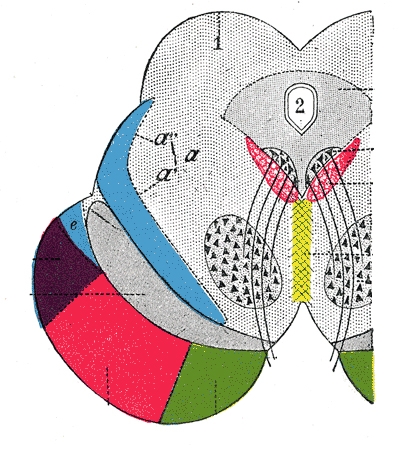The one-and-a-half syndrome arises from damage to either the abducens nerve nucleus, OR the PPRF. There is an associated lesion of the adjacent ipsilateral MLF, which originates from the contralateral abducens nucleus and has crossed the midline.
This lesion gives rise to both a gaze palsy and an INO (ipsilateral gaze palsy, diminished adduction of the ipsilateral eye on attempted gaze to the side opposite the lesion).
The only preserved horizontal eye movement is abduction of the contralateral eye.
Vertical gaze is preserved.
- Patients often present with the eye on the side opposite the lesion in exotropia, termed a paralytic pontine exotropia (the result of a tendency of the eyes to deviate to the opposite side of the gaze palsy; however, the eye on the affected side cannot move medially as a result of the INO, and therefore only the contralateral eye deviates)1. Patient shown has left pontine hemorrhage.

Figure from Professor H Foyaca-Sibet, University of the Transkei
- An ipsilateral INO (failure to adduct eye) and VI fasciculus lesion (failure to abduct eye) can produce paralysis of both adduction and abduction in one eye (noting that there should be also abducting nystagmus in the contralateral eye as a result of the INO)1.
Etiology
The main causes of one-and-a-half syndrome are brainstem ischaemia, haemorrhage, and tumour2.
Lesion of the left MLF and left PPRF/left abducens nucleus, giving rise to:
- Horizontal gaze palsy to the left
- Left INO (failure to adduct with left eye, and abducting dissociated nystagmus in the right eye)

Gaze palsy to the right, and right INO.
(vv)1 And A Half.mp4(tt)

